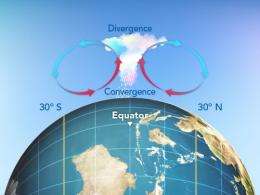Tropical clouds hold clues for the global water cycle

(PhysOrg.com) -- To study the wellspring of atmospheric water, you have to start with tropical clouds. Scientists at Pacific Northwest National Laboratory showed that global climate models are not accurately depicting the true depth and strength of tropical clouds that have a strong hold on the general circulation of atmospheric heat and the global water balance. Their analysis points to the need for model improvements to project water cycle changes in the 21st century. The research was published in the Journal of Climate.
As the Earth's climate warms, the sources and availability of water are affected. But how well are those changes predicted in global climate models today? Scientists are working to understand how moisture "moves" through the atmosphere and causes precipitation around the world. Understanding how well climate models represent these processes will help reduce uncertainties in the model projections of the effects of global warming on the world's water cycle. Equipped with more accurate projection tools, policymakers can get a better grip on how the climate changes will impact future availability of water and extreme weather events.
Researchers Drs. Samson M. Hagos and L. Ruby Leung, atmospheric scientists at PNNL, surveyed tropical divergence in three global climate models, three global reanalyses (models corrected with observational data), and four sets of field campaign soundings. Their survey uncovered significant uncertainties in current climate projections of the intensity and vertical structure of the low-level convergence of moisture to and upper-level divergence of heat away from the tropics. These current uncertainties are also reflected in future climate projections by these models.
The research team divided the total circulation providing moisture for precipitation into three parts: deep-divergent, shallow-divergent, and non-divergent. They found that in the tropics and subtropics, deep divergent circulation is the largest contributor to net precipitation, or total precipitation minus evaporation. Further, all global circulation models studied portray this process as deeper and stronger than what is observed in field measurements.
"Inter-model differences in the present day climate simulations inevitably carry over to future projections of climate change," said Hagos, lead author of the study. "Identifying these uncertainties provides a strong basis for model improvements."
Understanding how well climate models depict net precipitation gain was the first step. Next, scientists will work on correcting the representation of tropical cloud depth in global climate models to better project future climate change.
More information: Hagos S and LR Leung. 2012. " On the Relationship Between Uncertainties in Tropical Divergence and the Hydrological Cycle in Global Models." Journal of Climate, 25 (1), 381-291. DOI:10.1175/JCLI-D-11-00058.1
Journal information: Journal of Climate
Provided by Pacific Northwest National Laboratory
















